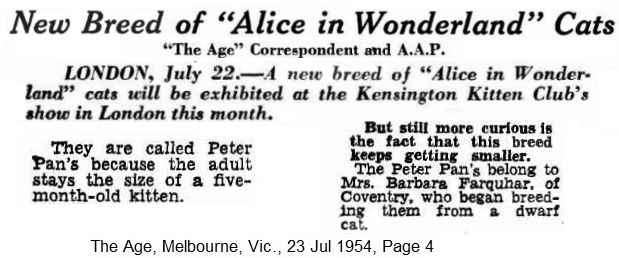
DWARF, MIDGET AND MINIATURE CATS (INCLUDING "TEACUP CATS")
HISTORICAL CASES AND RANDOMBRED CATS
Those seeking miniature cats (often known as "teacup cats") should be warned that not all petite cats are dwarf or miniature. The normal size range for cats is around 5 lbs to over 12 lbs and cats at the lower end of this spectrum are not necessarily miniatures. I have seen some advertisements claiming that cats under 10 lbs are miniature, when in fact they fall well within the normal size range!
These pages neither promote nor condemn dwarf and midget cats. They are intended as a source of balanced information, presenting the potential health issues as well as describing miniature mutations and breeds.
|
IMPORTANT NOTE I regularly receive emails asking where to buy pet miniature cats or cats which "always stay kittens". I do not breed or sell miniature cats. I do not have a list of breeders for different areas. The only contact details I have are those already contained in this article (with the breeder's agreement). Other small breeds (Singapura, Munchkin) are advertised in cat magazines and on the internet. True miniature cats are still rare and will be expensive because they are needed by breeders and only a few are sold as pets. Links and photos provided by breeders are for informational purposes and do not constitute an advertisement. Miniature cats do not "always stay kittens". They grow up into adult cats and lose their kittenish looks and habits. The only difference is their size. If you are looking for a cat that will always be a kitten, you will be disappointed. |
|
Miniature and Midget Cats Recorded in History |
MINIATURE AND MIDGET CATS RECORDED IN HISTORY
In 1830, the German explorer Rengger described a South American Cat which was "smaller by a fourth" than the common domestic cat. This indicates a cat 75% of usual size - not particularly small. In 1890, Charles Darwin gave a second hand account of the "Paraguay Cat" described by Rengger: "The domestic cat, which has been bred for 300 years in Paraguay, presents a striking difference from the European cat; it is smaller by a fourth."
In 1896, Richard Lydekker wrote of a midget cat found in South America which was "one fourth the size of the ordinary domestic breed and is characterised by its elongated body, and its covering of short, shiny and close-lying hair, more especially on the tail." He called it the Paraguay Cat and described it in his book "Handbook of the Carnivora". Although many dismiss this as a figment of Lydekker's imagination (or poor copying of "smaller by a fourth" into "one fourth the size"), the modern occurrence of miniature cats down to only 3 lbs mature weight, suggests that there may indeed have been a localised mutation of domestic cats.
A reader in Pennsylvania wrote to "Our Cats" (Dec 1958) regarding a domesticated strain of cats in Paraguay, the individuals of which were miniatures (whether the reader wrote from personal observation or was referring to the above instances is unknown). The adults weighed only about three Pounds. Their bodies were noticeably elongated, and the hair, more especially on the tail, is short, close and shiny. There are suggestions that the strain had been derived from the jaguarondi. The magazine's genetics correspondent, A C Jude, hoped, for more details of those miniature cats and their origin, and that someone might even be in a position to do experimental breeding by crossing them with normal breeds to produce something else new in the Cat Fancy.
In Frances Simpson's "The Book of the Cat" (1903), contributor H C Brooke wrote "We have seen specimens of a very tiny domestic cat, full-grown individuals of which weigh only about three pounds. Those we saw came from South America." In 1973, the Cats Protection League's Haslemere Shelter reported the case of "Little Purrer" a dwarf kitten that had come into their care and was doing well. Little Purrer was reported in the Branch news of "The Cat" but there are no details of his final size or weight.
”Cat Gossip,” June 27th, 1928: [Regarding a show in Vienna] A class was provided for Zwerg-Angora — dwarf Angoras. If this class be retained care will have to be taken that it does not become the happy hunting-ground of “weeds.” An exhibitor, who is doing good work in the production of amber-eyed whites, tells us he is producing a breed of dwarf cats, perfect and typical in every respect, but which he will not show until he has fixed a strain which, full grown, shall be but half the average size. Such a tiny cat would almost have the charm of perpetual kittenhood. – HC Brooke
”Cat Gossip,” 11th September, 1929: “Professor Schwangart, of Dresden, the eminent scientific (as opposed to Fancier) authority on Cats, writes of Dwarf Cats (to which Mr. H. C. Brooke referred in his Vienna report last year): ‘Dwarf Cats are nothing new. The discoveries of skeletons made by R. F. Scharff in Ireland prove that in bygone times, besides house cats of normal size, a dwarf variety was kept, the bones of which were only of the size of those of a Marten. The dwarf cats now being carefully bred in Germany are, we hear, most fascinating.’ "

In 1955, Albert C Jude reported the occurrence of miniature cats in a breeding line of British Shorthairs. While his book "Cat Genetics" was in preparation, an interesting case of dwarf or miniature cats came to his attention though there was not enough time to establish any genetic facts. He added that some combined problems, which he did not elaborate upon, were involved. A sadly indistinct photographic illustration showed the relative size of one of the miniatures as being two thirds the size of the well-known black Shorthair Ch. "Bourneside Inky Bits." The miniatures were being bred by Mrs B Farquhar of Coventry, England. A somewhat smaller than normal Black Shorthair mated with an unknown male resulting in 2 Black Shorthair kittens: "Peterpan Black Jade," and "Peterpan Black Angus Gohome.". As adults, the two offspring were also smaller than normal, but not miniatures. Jade and Angus were mated together 3 times (brother-sister inbreeding) and each succeeding litter contained kittens smaller than those of the previous litter. One of the offspring was mated back to its sire (father-daughter inbreeding) resulting in smaller kittens. Such inbreeding brings recessive genes to the fore. Jude omitted to note that there is no genetic reason for each succeeding litter to contain smaller kittens.
Jude wrote of the kittens, litter sizes and maturation rates: "The smallest kittens so far are about equal in size to an average six-months-old Siamese. These miniatures are slow to mature and are not ready for breeding until about two years old. Litter number is small, which is in accordance with the general expectation for smaller breeds of particular animals. For instance, in dogs the average litter size for bloodhounds is 10.06, whereas for the toy breeds it is 4.24 (Heape 1908). It is interesting to note that "Angus" mated with normal-sized queens, has produced only normal-sized kittens, This may be significant. A further matter of interest is that in this household a Siamese queen contracted show fever and was nearly lost. She passed this on to all other cats on the premises in varying degrees, but none of the "miniature" breed was affected, although these were in contact throughout."
The following recent cases were all loosely termed "dwarf" cats when reported. The descriptions generally suggest pituitary dwarfism (midgetism) or miniaturisation not achondroplasia dwarfism so I have loosely classified them as midgets.
Some genuine feline dwarfs or midgets have weighed under 4 lb (under 2 kg) when fully-grown. A tiny female shorthair called "Kitu" owned by Wanda Mitka of Laverton, Victoria, Australia was examined at the University of Melbourne School of Veterinary Science in 1979. Kitu was 7.87 in (20 cm) tall at shoulder, but perfectly formed and in perfect health. Her diminutive stature was due either to a genetic mutation or a congenital problem (birth defect) causing her to simply stop growing.
Even smaller than Kitu, was a male Siamese/Manx cross called "Ebony-Eb-Honey-Cat" owned by Angelina Johnston of Boise, Idaho, USA. In 1984, aged 4, he weighed only 1 lb 12 oz (792 g) but ate as much as a 12 lb (approx 5.5 kg) cat in the same household.
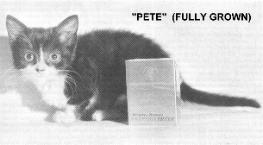
The smallest dwarf cats on recent record were "Pete" (b. 1973) and an un-named female (report dated 1983). Pete was described as a "boisterous" dwarf male cat (b 1973) owned by Jackie Reed of Bognor Regis, Sussex, England weighed only 12 oz (339 g) at the age of 3 months compared to 3.4 lb (1.6 kg) for his normal-sized littermates. Pete's weight never exceeded 2 lb (907 g) when he was full grown. A 2 year old dwarf female owned by Mrs M Wildgoose of Gillingham, Kent, England weighed only 2 lb 15 oz (1.3 kg) in 1983.
More recently, the world's smallest cat was reported to be a male blue point Himalayan (Colourpoint Persian) named "Tinker Toy" owned by Katrina and Scott Forbes of Illinois. Tinker Toy stood 7 cm (2.75 inches) at the shoulder and 19 cm (7.25 inches) long - presumably excluding tail. He weighed 1 lb 8 oz, lighter than Pete at maturity.
"Smallest Living Domestic Cat" World Records
|
Note: Many visitors to this web-page believe their cat may be a contender for the "Smallest Living Domestic Cat" World Record. If so, you will need to contact Guinness World Records directly. They will tell you how to submit your cat's details. Your cat must be full grown. You have to provide photos (showing your cat against a ruler for scale) and details of your cat's weight and nose-to-tail-tip length. Size and weight details must be independently verified by 2 veterinarians. The application form can be 10 pages long. |
In November 2003 the Guinness Record was held by 2 year old Itse Bits, A Himalayan/Siamese mix, who measured 9.52 cm (3.75 inches) high and and 38.1 cm (15 inches) long. In July 2004, there were 3 other contenders for the Guinness title of "World's Smallest Living Domestic Cat".
One contender (claimed by some cat magazines to be the actual record holder) was Mr Peebles, from Pekin, Illinois, USA, weighs only 3.3 lbs (1.5 kg) at 2 years old (normal weight for a 2 year old cat is 8 - 10 lbs/3.6 - 4.5 kg). Mr Peebles is now full grown and his small size is due to a genetic mutation. He eats 4 meals a day to sustain his weight, squeaks rather than meows and, because of his small size, he feels the cold. He is co-owned by Robin Svendson and Dr Donna Sassman of the Good Shepherd Veterinary Clinic in Pekin. He was found when Sassman did a house call to a farm in Tazewell County; his mother and several siblings were all of normal stature. Sassman was told she could have the runt of the barn cat litter if she could catch him! During 2004, clinic manager Cathy Smith, researched the Guinness World Record website for records of small cats. After providing photographic evidence and independently verified measurements, Mr Peebles' vital statistics were confirmed as 6.1 inches (15.5 cm) tall and 19.2 inches (48.76 cm) from his head to the tip of his tail (his tail is just over 7 inches /17.8 cm). His head and eyes are disproportionately large; a spinal defect means he cannot arch his back like normal cats (his back is very stiff, but apparently not fused though there is a risk of arthritis) and his spinal problems make him waddle like an alligator when walking, but he is otherwise healthy. This is still larger than Itse Bitse.
A 7 year old cat called Maggie, owned by Debra DeBerge of Colfax, California, USA, is claimed to weigh less than 3 lbs (1.36 kg) and to be smaller in size than Mr Peebles. So far her size and weight have not been verified. Maggie was abandoned by her mother at a young age and suffered malnutrition. A 2 year old cat called Gizmo, owned by Karen Murphy from Marlton, USA, weighed in at only 2 lbs (0.9 kg). Again, her small stature is believed to be due to a genetic mutation. At the time of this update, Gizmo's vital statistics are being verified by veterinarians. She was very sick as a newborn kitten, but is now healthy and has a good appetite. Whether she is smaller than the current holder remains to be seen.
In March 2006, a 9-week-old kitten from El Cajon, California was expected to take the record for the smallest cat in the world. At 9 weeks, "Heed" was 3-inches tall and weighed 1.2 pounds - not much larger than a 2-3 week old. Heed will not reach adult size until 6-8 months, but was expected to take the record for smallest cat in the world. His owner had already contacted the Guinness Book Of World Records, but may be disappointed - many undersized kittens lag 2-3 weeks behind normal kittens in growth and turn into near-normal adults.
In October 2011, the Guinness World Record for the world's shortest living cat went to a 3 year old Munchkin called Fizz Girl,owned by breeder Tiffani Kjeldergaard, of Southern California. Fizz Girl measures only 6 inches at the shoulder. This is short, even by Munchkin standards, but like most Munchkins Fizz Girl still climbs to high vantage points around the home. Previous record-holder, Itse Bitse (3.75 inches tall) unfortunately went missing.
MINIATURE CATS IN THE RANDOM-BRED POPULATION
November 2003 saw a rash of dwarf cats in my inbox: Debbie Klesel (USA) obtained a kitten called "Heath" who had been diagnosed as a dwarf. Heath was reported to be in excellent health and blood tests showed no problems. Sandi Monday of Knoxville, Tennessee, USA had three dwarf kittens from the same litter; at 6 months old they were about 4-5 inches tall and weighed 2-3 lbs each. Stephanie (no other details given) is a cat rescuer who had a kitten which was not growing. She had had the kitten for one month and its age was estimated at 7 weeks yet it was only half the size of some five week old kittens. This kitten had put on only 1 ounce in weight in four weeks despite being healthy and eating well. Her vet had never encountered a dwarf cat before.
In 2007, Vasilis Lekkas from Athens (who is deeply involved in the recently formed Greek network for the preservation of domestic livestock including cats) reported one instance of a reduced size adult female, about 50% of the size normally expected in Greek cats.
In 2008, Sonia Whidden reported midget kittens being born to an inbred feral colony. She took in a tiny male in 2007 who had become very ill at the age of 5 months. He has short legs, no teeth and a strangely formed mouth. The same mother gave birth to 3 more kittens: one full size, one short-legged midget and one blind kitten half normal size.
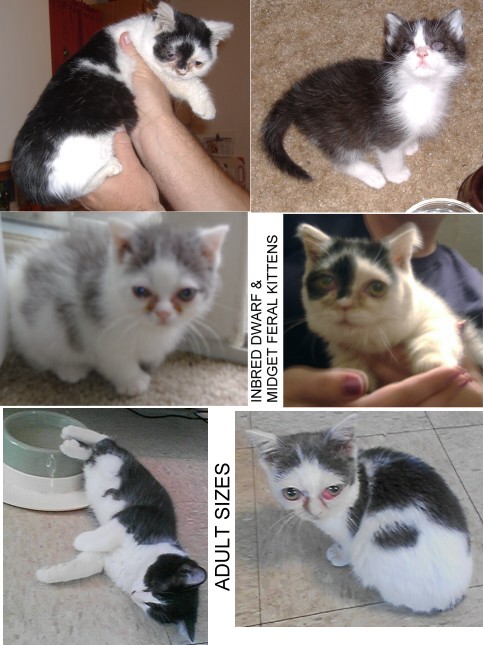
Sadly on October 30,2008 the black and white midget was put to sleep aged 2 years due a bladder infection resulting from severe megacolon that was obstructing his urinary system. He had major intestinal abnormalities that did not show until he got older. He would not have survived surgery. The second midget is much smaller and has not been able to eat hard cat food. His mouth malformed right and he has not developed teeth. Given a good diet, the black and white blind kitten thrived and grew normally while the grey and white remained small and seems to be mentally slow.
Sonia's cats resemble the description of Mucopolysaccharides 6, a recessive genetic condition causing slow growth (one form results in dwarfism) and facial dysmorphia: short, broad nose, flat-looking face, depressed nasal bridge, widely spaced eyes and small ears. Mucopolysaccharidosis 7 is another recessive mutation and has been found in feral kittens from an inbred colony in California; they had stunted growth and short limbs, but also had paralysis, fused bones and were prone to respiratory diseases (the California kittens died between 7 and 21 months). Both conditions cause an enzyme deficiency.
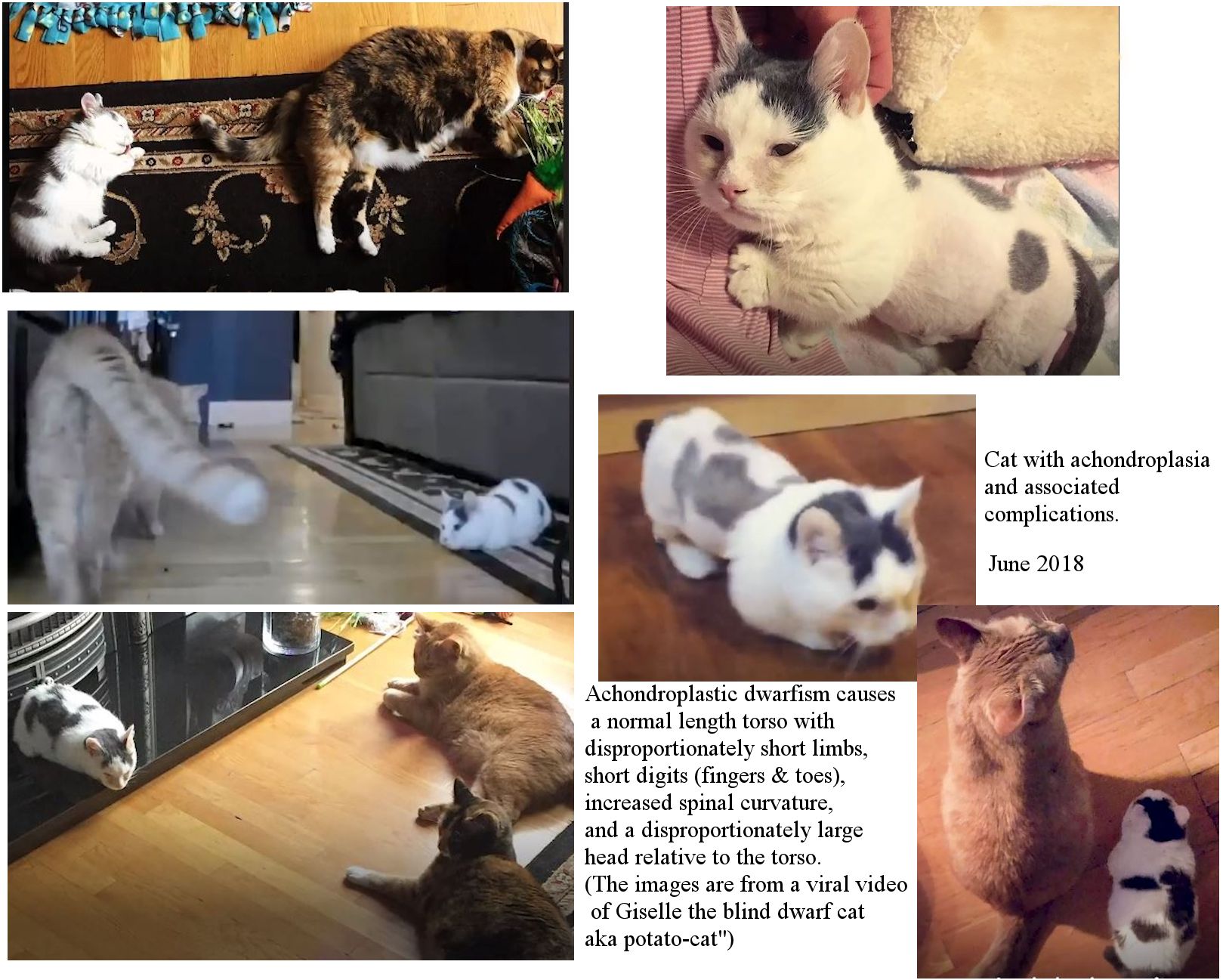
The following are detailed case studies from owners kind enough to share information to help others who take on dwarf cats.
Darla
In 2013 Allyson Dill from Nova Scotia, Canada, provided Messybeast.com with information and photos of her parents' cat, Darla who was adopted after being allowed to stray. Darla is uniformly petite; much smaller than any other cat that her parents had owned. Darla also has a disproportionately short, fat tail. It is suspected that her small stature is the result of inbreeding. While living as a stray, Darla had produced small litters of normal-sized kittens. The first known litter was born outdoors and comprised 3 kittens, none of which survived. Darla became pregnant again in early 2012 and gave birth indoors to 3 normal-sized, healthy kittens. The photos show Darla with Oscar, a normal-sized deaf white from the island of Saba, and Darla with her kittens
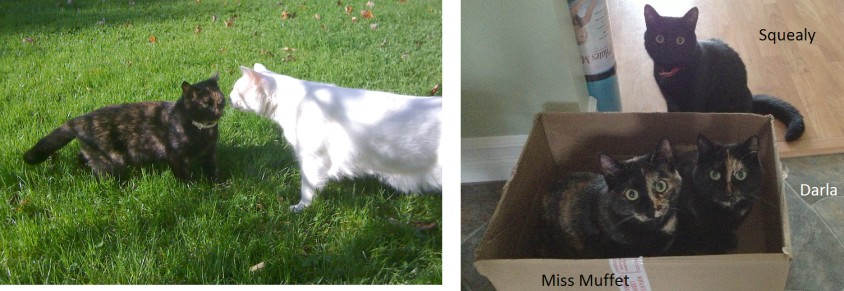
Darla does not meow or purr, and she communicated with her kittens using a barely-audible squeak. Two of the kittens are similarly silent, while the third is extremely vocal (hence named Squealy!). All 3 kittens inherited aspects of their mother's delicate bone structure (tiny feet, etc), but only one inherited the shortened, thick tail. All three quickly outsized Darla by 6-8 months of age. She is shown with her daughters in the fourth picture.
Though still an outdoor hunting cat at heart, Darla is now spayed and spends more time indoors. The vet was unable to determine her age, but confirmed she had no health problems.
Nina
In August, 26th 2009 Elizabeth Bangs in Maine took in a 1-2 day old flea infested black-and-white kitten abandoned by its mother. In her locality there is a known problem with inbreeding among ferals and the kitten, Nina, showed a number of health issues including small size. She was a small kitten and initially grew normally, but her growth rate slowed and she did not reach 2.8 lbs until she was over 2 months old. This suggests a problem that became evident as she was weaned. Despite a sometimes ravenous appetite and propensity to steal food, Nina weighed only 3 lbs at 6 months old in February 2009. At 6 months old Nina still had many of her baby teeth, which hadn't loosened. Her first adult canine tooth proved to be weak and broke off, again indicating underlying problems.
Her most obvious problem is oversized stools that could not be passed without help (congenital megacolon). Metamucil, commonly used for constipation, made this worse. Nina has a high-fibre diet using pumpkin, boiled spinach and high quality protein to produce softer, more frequent stools. As a result of the oversized stools, her anal sphincter no longer fully closes, exposing part of the rectum (laxatives can't be used as diarrhoea would leak out, leading to urinary infections). She appears healthy and properly nourished though her chronic bowel problems, evident following weaning, may have stunted her growth.
Elizabeth can't afford to investigate a possible genetic cause of Nina's small stature or how the bowel problems are related to this. In adult cats, vets can sometimes remove the affected section of colon, but Nina's small size and possible underlying issues make this risky and the cost of investigative tests and surgery are prohibitive. At present her condition is managed and stable and her diet monitored. Despite her small size and known health issues, Nina is a happy, active cat though her long-term prognosis is unknown.
Grace
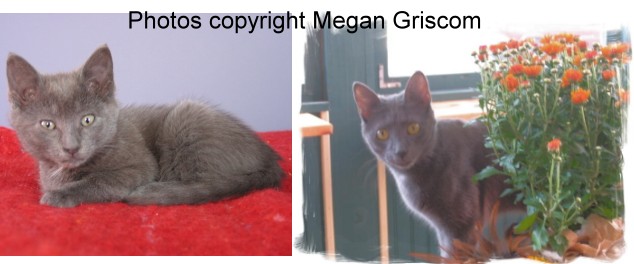 Megan Griscom (New Jersey, USA) provided information about her miniature cat, Grace, who was trapped with her two feral littermates at a farm. Grace was tiny from the start, 13 oz in Nov. 2006 and Megan assumed she was just a few weeks old. Her two litter mates were a black and a tuxedo grey that weighed about 3.5 pounds each and were getting their adult teeth. The vet presumed them to be about 4 months old. As they ate and grew, Grace lagged behind. She never ate more than a teaspoon of canned food twice a day. In Feb. 2007 her littermate went into heat and was spayed at 8 lbs, the tuxedo grey was nuetered the following week at 9 lbs.
Megan Griscom (New Jersey, USA) provided information about her miniature cat, Grace, who was trapped with her two feral littermates at a farm. Grace was tiny from the start, 13 oz in Nov. 2006 and Megan assumed she was just a few weeks old. Her two litter mates were a black and a tuxedo grey that weighed about 3.5 pounds each and were getting their adult teeth. The vet presumed them to be about 4 months old. As they ate and grew, Grace lagged behind. She never ate more than a teaspoon of canned food twice a day. In Feb. 2007 her littermate went into heat and was spayed at 8 lbs, the tuxedo grey was nuetered the following week at 9 lbs.
Megan was concerned over Grace's size and took her to the vet. She had a bad case of gingivitis but was otherwise healthy, just very small at 3.5 pounds, about 1/3 the size of her littermates. Return visits confirmed Grace had chronic gingivitis, or stolitis and she was given antibiotics. After about 2 weeks on the antibiotics, her appetite increased five-fold due to reduced mouth pain and 2 weeks after that she showed very mild signs of a short-lived heat.
Her stolitis continues and she has clyndomicin every few months for 20 days. She shows very weak signs of heat, but without calling (she has almost no voice) and for only 24 hours. She has a kitten size head, is very small and has very small facial structure. She retained her tiny, translucent kitten-like claws in tiny paws and retained her juvenile teeth, some of which have fallen out due to wear. The vet believes most of her teeth will be lost over time and Grace might not grow adult teeth. This will eventually resolve the bouts of stolitis. At 1.5 years old, Grace weighs 4 pounds 2 oz. She is not yet spayed due to her small size. She is an indoor cat and has no contact with unneutered males. She has a wicked personality, is very active and can get into much trouble due to her small size including climbing the curtains and sleeping in cereal bowls.
Flump
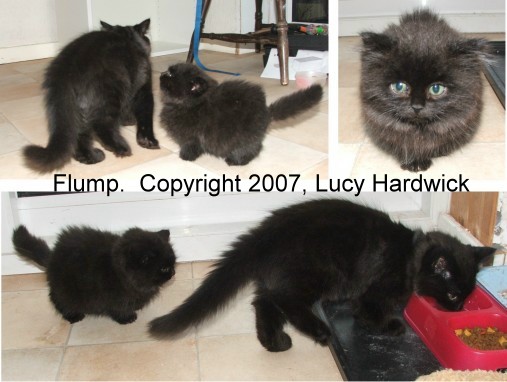 In Devon, England, Lucy HArdwick's cat had a litter of 6 kittens on the 9th September 2007, of which the last was stillborn. Kitten number 4, Flump, is different to the others. She is very small with short limbs, a compact dody, a relatively large head and an undershot jaw. At 12 weeks old she weighed just under 1lb. She is very affectionate (if a little slow) and the vet has declared her healthy. The photos show Flump and her litter-mate Cole at 12 weeks old. Flump is clearly much smaller and differently proportioned, having a different form of dwarfism to the short-legged Munchkin-type cats. It isn't possible to tell how large Flump will be when adult.
In Devon, England, Lucy HArdwick's cat had a litter of 6 kittens on the 9th September 2007, of which the last was stillborn. Kitten number 4, Flump, is different to the others. She is very small with short limbs, a compact dody, a relatively large head and an undershot jaw. At 12 weeks old she weighed just under 1lb. She is very affectionate (if a little slow) and the vet has declared her healthy. The photos show Flump and her litter-mate Cole at 12 weeks old. Flump is clearly much smaller and differently proportioned, having a different form of dwarfism to the short-legged Munchkin-type cats. It isn't possible to tell how large Flump will be when adult.
Yazzi
In October 2005, Carol Sweeney, who works for a feline rescue group in Orlando, Florida, received a small kitten that had been found in a parking lot. She had trouble estimating his age as he weighed only 13 oz - the weight of a 3 week old kitten - but he had all his teeth, adult eye colour and the motor skills and behaviour of an older cat. Named Yazzi, he was a picky eater and during the first week had seizures due to low blood sugar. Vet tests found no problems; his liver function was fine but his kidneys did not concentrate urine very well hence Yazzi drank lots of water. The vet had not encountered a dwarf or midget cat previously.
By December 2005, Yazzi weighed almost 2.5 lbs and had stopped growing. He was no underweight, just very compact. Yazzi was rehomed and remains 2.5 lbs. He now has adult proportions, but is very small. He has retained many kitten-like characteristics such as soft fluffy fur and a slightly larger head. He is unlikely to mature sexually and has tiny testicles that are proportionate for his size. He is also very quiet and rarely purrs. He cannot extend his claws and therefore cannot climb; although he uses a scratching post he still does not extend his claws!
Sadly Yazzi's fragile health deteriorated in October 2006. He became lethargic, anorexic and suffered seizures. His adopters gave him the best possible care during his short life and made the decision to put him to sleep to prevent further suffering.
Midge
In October 2002, I heard from Karen Boruff who had two miniature kittens born to a miniature female of unknown descent and an unknown male cat. She is interested in keeping their bloodline going if possible. Close to her family's home, Karen Boruff had been feeding a miniature, feral cat which she had attempted to tame. Unfortunately, this miniature cat vanished, presumed poisoned. However, it was likely that a gene for miniaturisation was still present in the free-breeding feral population in that area. In 2002, Karen rescued an undersized female cat, Midge, from a rubbish bin outside an empty house in another area. Midge was undersized, covered in sores, had hardly any fur and had obviously suffered long-term neglect. The Vet assumed that Midge's growth had been stunted by hardship. Midge escaped from the house while in call and later produced 4 kittens including miniatures Cotie and Scamp. Since this was the area where the miniature feral cat had lived, it is possible that Midge mated with a descendent of that cat.
Midge produced four kittens: one was near normal size, one was small, and two (a male and a female) were tiny. The small size of the kittens could have been accounted for by Midge's small size i.e. not much room for growth in the womb. Midge (and several other pet cats in the area) was apparently deliberately poisoned when the kitten were 5 weeks old. As the kittens grew, it was evident that some were near normal size and others remained miniature. At 128 days old (approx 4 months), Cotie weighed only 1 lb while Scamp was 14 oz. A more normal-sized litter-mate was 4 lbs. All were healthy and active, regardless of size and the miniatures are perfectly proportioned. As well as being miniatures, Cotie and Scamp appear to be ring-tailed cats i.e. their tails curl up and over their bodies.
Karen is interested in a serious breeding program with her miniatures and to find out the mode of inheritance. A number of test matings will be needed between related cats (who may or may not carry the gene) are needed to find out whether the trait is recessive or dominant. Since Midge was killed, it was not possible to mate her son back to her. By January 2004, Cotie had matured at 2 1/2 pounds at full weight and Scamp had matured at a little under this. This line of miniature cats seem to become sexually active much younger and with much less warning than the normal sized cats. In April, Karen was surprised when Scamp displayed signs of late pregnancy. Despite worries, the three kittens were born 45 minutes apart and were healthy. Cotie was neutered and rehomed. The smallest male kitten was kept and the others were neutered and rehomed.
Scamp gave birth again at the end of September 2003; again without problems. One of the female kittens, Bella, was very unique. She was so small at birth that Karen thought she was premature (e.g. a case of superfetation where two matings result in different age embryos) and she didn't expect her to live. Bella is healthy, albeit very, very small and unlikely to grow much larger according to the vet. Bella has another odd quirk in that she has no claws on her back paws, and only a few of the front toes have claws. Only a test-mating will show if the trait is passed on. Karen has kept a heredity chart which indicates that using an Normal Small (NS) for both Scamp (mother) and Rusty (father) results in one Normal (NN), two Normal Small (NS) and one Very Small (SS). Of the kittens, Colonel is heading towards being a low weight normal size cat; Tim and Beau both appear to be small like Scamp, while Bella is extremely small. The two males will be mated back to Scamp and to their sister, Bella, to promote the small size and possibly the clawless trait.
Karen Boruff's breeding programme is under local veterinary supervision and is at a very early stage - 2 generations, compared to 5 generations in the Toyland Persians - so there is far less data available. Heredity charts are being maintained, but it has not, as yet, been referred to a feline geneticist. The rate of small offspring to normal-size offspring corresponds to that found with Treker (Toyland Persians) and suggests a similar dominant mutation, especially as it also produces both normal small (toy) and very small (teacup varieties). Unlike the case of Treker, the ancestry of the original miniature feral female is unknown.
Blueberry
 In August 2003, Guyna Horne of BuckSnort Large Animal Rescue in Texas sent details about a miniature kitten born on their farm. Guyna reported that cats and dogs were sometimes dumped near the farm, where they fell victim to coyotes or bobcats unless rescued. Guyna had rescued a dumped female called "Light", a smallish bright white female with gold eyes.
In August 2003, Guyna Horne of BuckSnort Large Animal Rescue in Texas sent details about a miniature kitten born on their farm. Guyna reported that cats and dogs were sometimes dumped near the farm, where they fell victim to coyotes or bobcats unless rescued. Guyna had rescued a dumped female called "Light", a smallish bright white female with gold eyes.
Light weighed about 5 lbs and had produced two normal-sized kittens (Nimbus and Sirius, both blue-eyed whites with full hearing) and a noticeably smaller tortoiseshell kitten. At this time it didn't occur to Guyna that the small kitten was anything special. Light managed to get pregnant before her spay surgery, the male (now deceased) was another small cat, again about 5 lbs. This mating produced 5 kittens of which 4 were normal sized and one was miniature.
Of Light's second litter, three kittens were pure white, one was tortoiseshell and one was a blue-point (Blueberry) with a slightly darker than normal coat even for an old fashioned Siamese. All of the kittens (the "Berries") except Blueberry were normal size for their age (5 weeks) and weighed between 19 oz and 25 oz. Blueberry only weighed 9 oz. One of Guyna's neighbours adopted a dumped red-point male about the time Light was found. Since Light has produced a colourpoint kitten, this cat could be Light's father or brother. A degree of inbreeding might be causing a miniature recessive trait to show up in Light's kittens.
At first, Guyna though Blueberry was not getting enough to eat. She removed the other kittens for about 15 minutes, 5-6 times a day, hoping that Blueberry would get more to eat and catch up in size. Although Blueberry was obviously getting enough to eat she was still very tiny. Guyna started some supplemental feeding at five weeks and Blueberry ate with great enthusiasm, but remained tiny! It then occurred to Guyna that there could be mini-cats in the same way as there are mini-cattle!
Blueberry apparently doesn't realize that she is not the same size as her littermates. She is so tiny that when she zooms around she looks like a toy "penny racer" car. Her proportions are well balanced and she seems to have a bit of a "smooshed" face, but not as much as a Persian, which suggests that the colourpoint gene might come from Himalayan (colourpoint Persian) ancestors. The one difference Guyna noticed was that Blueberry seemed to get tired a bit faster than her siblings.
Blueberry update, May 2005: Guyna named Blueberry due to her eye color and her tiny size, but like many Texans has nicknamed her pet. Blueberry has become "Bou" ("boo"). Bou is now a bit over 10 months old and weighs 3 lbs 10 oz. She enjoys eating and is a little heavy for her diminutive size. She is also very active and has discovered that she can jump up much further than one would think such a small cat could. She having to learn to jump on the kitchen counters. Below is a recent picture of Bou and I would love to hear from other mini cat owners.
Tellie
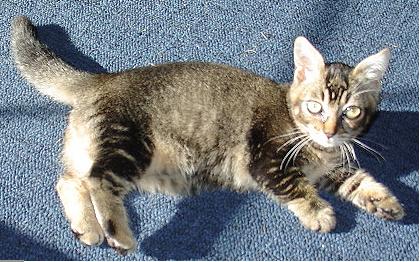
The following detailed account of a cat with achondroplasia is provided by Aimee Johnson in October 2003. Aimee has allowed me to use the information and photos to provided information other owners of cats with dwarfing conditions. Unlike the apparently healthy Munchkins, "Tellie" suffers a number of health problems, some linked to his condition and others possibly due to inbreeding and birthing problems. At the time of this account, Tellie was four and a half months old.
Tellie, was born to a feral mother whose brother and father had mated with her. The feral female was small, was not noticeably pregnant and probably did not get proper nutrition during the pregnancy. Her size may have led to a difficult birth for the kittens. Tellie had one sibling, a brother who was killed by a pit bull terrier. This sibling did not have achondroplasia, was extremely healthy and was dominant, sometimes preventing Tellie from nursing. From birth, Tellie was a little slow in that he did not respond as much to stimuli, and was not nearly as active as his brother (possibly some genetic retardation due to inbreeding or oxygen starvation during birth). Up until 8 weeks, Tellie also had a distended belly.
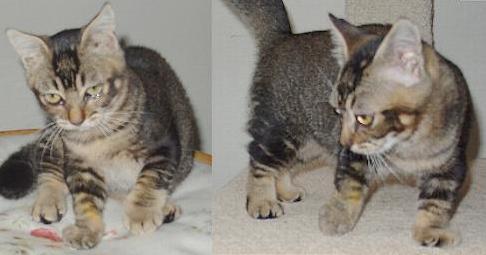
Tellie has remained exceedingly small since birth, and suffers long-standing respiratory difficulties (often extreme) from birth and throughout his life, even after several courses of antibiotics. He wheezes and snorts constantly; antibiotics help with the congestion but he breathes noisily and with difficulty. His eyes weep constantly, especially after he eats (which suggests some cranial deformities affecting nasal passages and tear ducts). He has a small ridge down his palate, and one vet speculated he would suffer various problems all of his life. At the age of fourteen weeks, Tellie broke his right front radius, which has since healed with surprising rapidity (two weeks). At fourteen weeks Tellie weighed 3 lbs, 8.5 oz and the vet noted a Munchkin-type condition.
The vet who examined his x-rays said Tellie would be at a higher risk of breaking a disc in his back. This is because his shorter legs don't act as shock absorbers as efficiently as normal length legs, putting more strain on his back when he jumps down from surfaces. To prevent further broken bones in his legs and to reduce the likelihood of back damage, Aimee has provided stools and ramps to those surfaces Tellie climbs onto so he doesn't have to jump down. Tellie is extremely rambunctious, curious, and full of energy. He likes to climb, but is hesitant of jumping down because the impact is not cushioned by his short legs.
Nip
On August 11th, 2003, a Siamese-type female barn cat in South Dakota produced 8 kittens, of which 5 survived. The smallest kitten died and another undersized kitten, dubbed "Nip" by the owner (Karen), was about one third the size of his litter mates. He was black, with over-large ears, a long nose and a scrawny tail and has remained a small cat. This was initially attributed to being the smallest survivor of a large litter. However, during March 2004, Nip's mother produced 3 kittens, of which 2 survived, but a tiny female died. The two surviving males weighed 1 pound at 12 weeks of age. This suggests that Nip's small stature was not due to malnutrition as he has sired small kittens and his mother has continued to produce small kittens. A granddaughter of Nip's mother (Nip's niece), weighed 1lb 2 oz at 14 weeks.
An update in July 2004 indicated that Nip has grown from a scrawny kitten into a handsome cat 7 inches tall. He has sired 2 litters of kittens on smaller sized females. The first mother was tabby Pixie; taller, but smaller boned then Nip who produced 6 kittens. The smallest, Kip, also a black male, weighed 7 ounces at 26 days old. Like Nip, Kip was born very small. The other 5 all weighed 9 ounces or more. The mother, Pixie, is unrelated to the other cats, so inbreeding is not the cause of the small stature. The second litter sired by Nip on a Siamese-type female were all about half the normal kitten birth weight. Over the last 10 years, all of Karen's cats (including newcomers) have been on the small side so the trait of smaller than average stature has apparently become fixed.